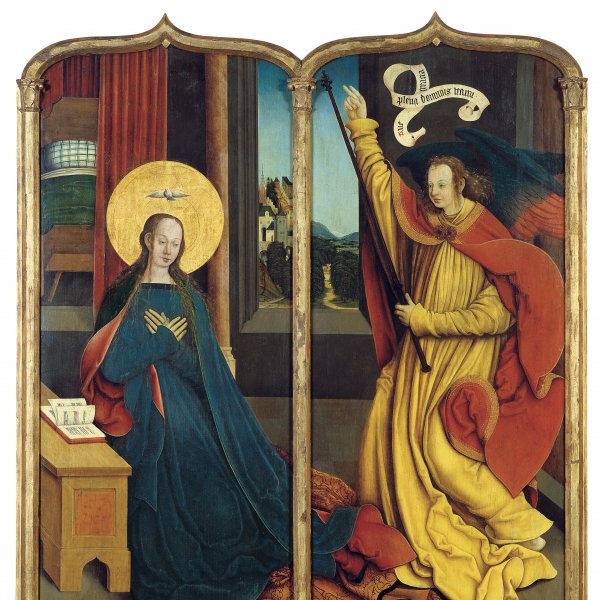Saint Paul and Saint Anthony the Hermit (reverse)
Bernhard Strigel was an important German painter of the late 15th and early 16th centuries. His work reflects the influence of other leading painters of the day such as Dürer and Dieric Bouts. These two panels in the Thyssen-Bornemisza Collection must have been part of a large ensemble that probably had a sculpture or group of panels in the centre. The present two panels would have been located to either side. Their exterior faces now have sculpted, polychrome wooden reliefs of Saint Anthony and Saint Paul. These would probably have originally been the interior wings of the original altarpiece designed by Strigel, whose central sculptural element is now lost. The present paintings of the Virgin and the Archangel Gabriel reveal the influence of Flemish religious art. The figures, with their elongated proportions, are set in a room with a window that looks onto a landscape and functions to unify the two panels by forming a single background. Mary is seated before a reading desk. Within her halo is the Dove of the Holy Spirit, while her hands crossed on her breast indicate her acceptance of the divine message and her spiritual submission. Gabriel’s staff indicates the Archangel’s role as emissary. He is depicted in movement with a banner above him that reproduces his words of salutation to Mary. Strigel uses brilliant, striking colours with a particular emphasis on reds and golds.
These oil paintings on panel of the Annunciate Virgin and Angel were originally the exterior wings of a larger ensemble. On the reverse and attached to the original panel are two carved, polychrome wooden reliefs. These sculptures, which depict the hermit saints Paul and Anthony, were originally the interior wings of the altarpiece designed by Strigel. The central element, which was probably a sculptural group, has not yet been identified. It is not known when the panels and sculptures were assembled as they are now seen, at which point a thin frame of attached columns was constructed to join these two exterior panels, but it is likely that the work already had this structure when it was acquired in 1934 for the Thyssen-Bornemisza collection from an English private collection.
The attribution of the work to Berhard Strigel was made by Max J. Friedlander and Walter Hugelshofer, whose opinion on the panels was sought in 1934. Both art historians, in letters of 22 February and 22 June respectively, attributed the panels to Bernard Strigel, an artist based in Memmingen who probably trained in the family workshop, which was one of the most active in the production of altarpieces.
The influence of Flemish painting on this work is clearly evident. Strigel was familiar with the work of artists such as Dieric Bouts, who influenced his style in specific respects. This has led to the suggestion that Strigel visited the Low Countries but there is no documentary evidence on this issue.
The sculptural, stylised figures are set in a typical interior, to which their poses are adjusted to fit. Mary on their left is depicted accepting the divine message to judge from her gaze, the position of her hands and her modest pose. The dove of the Holy Spirit descends on her, floating just above her head and standing out against the great gold halo that frames her head. The angel, with its words of salutation written on the scroll, holds a messenger’s staff. Strigel locates a landscape in the centre of the composition that continues across the two panels, as do the draperies on the floor in the centre. The carefully considered chromatic range creates a sense of unity across the entire composition.
When compared to other paintings on this subject by Strigel painted earlier in his career this example has a more harmonious and balanced composition, while the tranquil, meditative poses are characteristic of his mature style. These panels could, for example, be compared with an Annunciation in a collection in Salem of around 1508, and another in the Staatliche Kunsthalle in Karlsruhe. Both works also depict the Virgin and Angel with long locks of hair falling around their faces.
The carvings on the back were attributed by Gertrud Otto to Hans Thoman, a sculptor who worked in the Strigel family workshop. In an article of 1968, Miller published them as by Christoph Scheller, comparing them to that artist’s work in the chapel of Saint Vitus in Schwaz, datable to 1511.Miller compared the faces and noted that the head of Saint Anthony in the present relief is very similar to the saint in the chapel. The most recent attribution of these sculptures was made by Michael Maek-Gérard, who also gave them to Scheller but with some doubts. With regard to their provenance, it is only known that they were in a private English collection and that they entered the Rohoncz collection in 1934. They were included in its 1937 catalogue. The panels with their sculptures had been unpublished until that date.
Mar Borobia









